Class 10 - Mathematics
Surface Areas and Volumes Exercise - Exercise 13.4
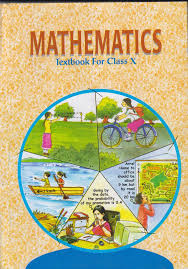
Top Block 1
Exercise 13.4
Question : 1:A drinking glass is in the shape of a frustum of a cone of height 14 cm. The diameters of its two circular ends are 4 cm and 2 cm.
Find the capacity of the glass.
Answer :
Radius (r1) of upper base of glass = 4/2 = 2 cm
Radius (r2) of lower base of glass = 2/2 = 1 cm
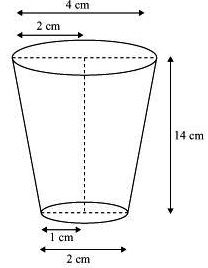
= πh[r12 + r22 + r1 * r2]/3
= πh[22 + 12 + 2 * 1]/3
= 1/3 * 22/7 * 14 * 7
= 308/3
= 102⅔ cm3
Therefore, the capacity of glass is 102⅔ cm3.
Question : 2:The slant height of a frustum of a cone is 4 cm and the perimeters (circumference) of its circular ends are 18 cm and 6 cm.
Find the curved surface area of the frustum.
Answer :
Perimeter of upper circular end of frustum = 18 cm
⇒ 2πr1 =18
⇒ r1 =18/π
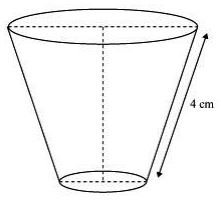
Mddle block 1
⇒ 2πr2 = 6
⇒ r2 = 3/π
Slant height (l) of frustum = 4 cm
CSA of frustum = π(r1 + r2)l
= π(9/π + 3/π) * 4
= 12 * 4
= 48 cm2
Therefore, the curved surface area of the frustum is 48 cm2.
Question : 3: A fez, the cap used by the Turks, is shaped like the frustum of a cone (see Fig. 13.24). If its radius on the
open side is 10 cm, radius at the upper base is 4 cm and its slant height is 15 cm, find the area of material
used for making it.
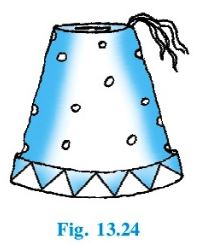
Answer :
Radius (r2) at upper circular end = 4 cm
Radius (r1) at lower circular end = 10 cm
Slant height (l) of frustum = 15 cm
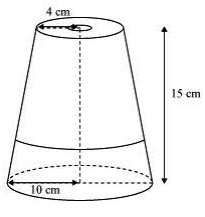
= π(r1 + r2)l + πr22
= π (10 + 4)15 + π (4)2
= π *14 * 15 + 16π
= 210 π + 16 π
= 226 π
= (226 * 22)/7
= 4972/7
= 710 2/7 cm2
Hence, the area of material used for making it is 710 2/7 cm2.
Question : 4:A container, opened from the top and made up of a metal sheet, is in the form of a frustum of a cone of height 16 cm
with radii of its lower and upper ends as 8 cm and 20 cm, respectively.
Find the cost of the milk which can completely fill the container, at the rate of Rs 20 per litre.
Also find the cost of metal sheet used to make the container, if it costs Rs 8 per 100 cm2. (Take π = 3.14)
Answer :
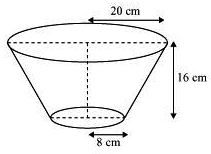
Radius (r2) of lower end of container = 8 cm
Height (h) of container = 16 cm
Slant height (l) of frustum = √{(r1 – r2)2 + h2}
= √{(20 – 8)2 + 162}
= √(144 + 256)
= √400
= 20
Capacity of container = Volume of frustum
= πh[r12 + r22 + r1 * r2]/3
= 1/3 * 3.14 * 16 * [202 + 82 + 20 * 8]
= 1/3 * 3.14 * 16 * (400 + 64 + 160)
= 1/3 * 3.14 * 16 * 624
= 3.14 * 16 * 208
= 10449.92 cm3
= 10449.92/1000 litres [1000 cm3 = 1 litre]
= 10.45 litres
Cost of 1 litre milk = Rs 20
Cost of 10.45 litres milk = 10.45 * 20 = Rs 209
Area of metal sheet used to make the container = π(r1 + r2)l + πr22
= π (20 + 8)20 + π (8)2
= π *28 * 20 + 64π
= 560 π + 64 π
= 624 π cm2
Cost of 100 cm2 metal sheet = Rs 8
Cost of 624 π cm2 metal sheet = (624 π * 8)/100
= (624 * 3.14 * 8)/100
= 15674.88/100
= Rs 156.75
Therefore, the cost of the milk which can completely fill the container is Rs 209 and the cost of
metal sheet used to make the container is Rs 156.75
Question : 5:A metallic right circular cone 20 cm high and whose vertical angle is 60° is cut into two parts at the middle of its height by
a plane parallel to its base. If the frustum so obtained be drawn into a wire of diameter 1 cm, 16 find the length of the wire.
Answer :
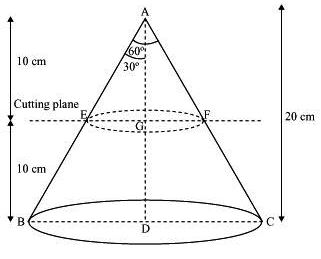
EG/AG = tan 30°
⇒ EG/10 = 1/√3
⇒ EG = 10/√3
⇒ EG = (10 * √3)/(√3 * √3)
⇒ EG = 10√3/3
In ΔABD,
BD/AD = tan 30°
⇒ EG/20 = 1/√3
⇒ EG = 20/√3
⇒ EG = (20 * √3)/(√3 * √3)
⇒ EG = 20√3/3
Radius (r1) of upper end of frustum = 10√3/3 cm
Radius (r2) of lower end of container = 20√3/3 cm
Height (h) of container = 10 cm
Volume of frustum = πh[r12 + r22 + r1 * r2]/3
= 1/3 * π * 10 * [(10√3/3)2 + (10√3/3)2 + (10√3/3) * (10√3/3)]
= 1/3 * π * 10 * [100/3 + 400/3 + 200/3]
= 10/3 * 22/7 * 700/3
= 22000/9 cm3
Radius (r) of wire = 1/16 * 1/2 = 1/32 cm
Let the length of wire be l.
Volume of wire = Area of cross-section * Length
= πr2 * l
= π(1/32)2 * l
= 22/7 * (1/32)2 * l
Volume of frustum = Volume of wire
⇒ 22000/9 = 22/7 * (1/32)2 * l
⇒ l = 7000/9 * 1024
⇒ l = 796444.44 cm
⇒ l = 796444.44/100 m
⇒ l = 7964.44 m

